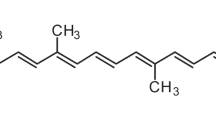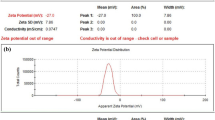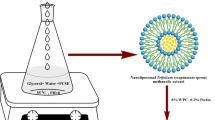Abstract
The objective of this study was to use accelerated-solvent-extraction to achieve antioxidant extracts from chia seeds oils, enriched in tocopherols and tocotrienols, namely tocochromanols. Nanotechnology applications have been also incorporated to develop an innovative formulation of chia seeds oil nanoemulsion that preserve its antioxidant potential after conditions of oxidative stress. Chia seeds oils proved to be a valuable source of tocochromanols, from 568.84 to 855.98 μg g−1, depending on the geographical provenance. Quantitative data obtained by LC-DAD-ESI-MS/MS showed outstanding levels of γ-Tocopherol, over 83%, followed far behind by Tocopherols-(α, β, δ) and Tocotrienols-(α, β, δ, γ)-tocotrienols. The characteristic tocochromanols fingerprint of chia seeds oils was positively correlated with the FRAP and DPPH antioxidant activity of the extracts (between 18.81 and 138.48 mg Trolox/g). Formulation of the Chia seeds oils as nanoemulsions did not compromised the antioxidant properties of fresh extracts. Interestingly, nanoemulsions retained about the 80% of the initial antioxidant capacity after UV-induced stress, where the non-emulsified oils displayed a remarkable reduction (50–60%) on its antioxidant capacity under the same conditions. These antioxidant chia seeds formulations can constitute a promising strategy to vectorizing vitamin E isomers, in order to be used for food fortification, natural additives and to increase the self-life of food products during packing.
Graphic abstract




Similar content being viewed by others
References
Ahsan H, Aha A, Siddiqui WA (2015) A review of characterization of tocotrienols from plant oils and foods. J Chem Biol 8(2):45–59
Alanon ME, Castro-Vazquez L, Diaz-Maroto MC, Hermosin-Gutierrez I, Gordon MH, Perez-Coello MS (2011) Antioxidant capacity and phenolic composition of different woods used in cooperage. Food Chem 129:1584–1590
Aranibar C, Aguirre A, Bo R (2019) Utilization of a by-product of chia oil extraction as a potential source for value addition in wheat muffins. J Food Sci Technol 56:4189–4197
Augustin MA, Hemar Y (2009) Nano- and micro-structured assemblies for encapsulation of food ingredients. Chem Soc Rev 38:902–912
Ayerza R, Coates W, Lauria M (2002) Chia seed (Salvia hispanica L.) as an omega-3 fatty acid source for broilers: influence on fatty acid composition, cholesterol and fat content of white and dark meats, growth performance, and sensory characteristics. Poult Sci 81:826–837
Benzie IFF, Strain JJ (1996) The ferric reducing ability of plasma (FRAP) as a measure of “antioxidant power”: The FRAP assay. Anal Biochem 239(1):70–76
Brigelius-Flohé R (2006) Bioactivity of vitamin E. Nutr Res Rev 19(2):174–186
Bustamante-Rangel M, Delgado-Zamarreno MM, Sanchez-Perez A, Carabias-Martinez R (2007) Determination of tocopherols and tocotrienols in cereals by pressurized liquid extraction-liquid chromatography-mass spectrometry. Anal Chim Acta 587(2):216–221
Borneo R, Aguirre A, Leon AE (2010) Chia (Salvia hispanica L) gel can be used as egg or oil replacer in cake formulations. J Am Diet Assoc 110:946–9
Capitani MI, Spotorno V, Nolasco SM, Tomas MC (2012) Physicochemical and functional characterization of by-products from chia (Salvia hispanica L.) seeds of Argentina. LWT-Food Sci Technol 45(1):94–102
Castejon N, Luna P, Senorans FJ (2017) Ultrasonic removal of mucilage for pressurized liquid extraction of omega-3 rich oil from chia seeds (Salvia hispanica L.). J Agric Food Chem 65(12):2572–2579
Castro-Vazquez L, Alanon ME, Rodriguez-Robledo V, Perez-Coello MS, Hermosin-Gutierrez I, Diaz-Maroto MC, Jordan J, Galindo MF, Arroyo-Jimenez MD (2016) Bioactive flavonoids, antioxidant behaviour, and cytoprotective effects of dried grapefruit peels (Citrus paradisi Macf.). Oxid Med Cell Longev 3:1–12
Chen MH, Bergman C (2005) A rapid procedure for analysing rice bran tocopherol, tocotrienol and y-oryzanol contents. J Food Compos Anal 18(4):139–151
Chen LY, Remondetto GE, Subirade M (2006) Food protein-based materials as nutraceutical delivery systems. Trends Food Sci Technol 17:272–283
Coradini K, Lima FO, Oliveira CM, Chaves PS, Athayde ML, Carvalho LM, Beck RC (2014) Co-encapsulation of resveratrol and curcumin in lipid-core nanocapsules improves their in vitro antioxidant effects. Eur J Pharm Biopharm 88(1):178–185
da Silva JK, Cazarin CB, Colomeu TC, Batista AG, Meletti LM, Paschoal JAR, Zollner RD (2013) Antioxidant activity of aqueous extract of passion fruit (Passiflora edulis) leaves: in vitro and in vivo study. Food Res Int 53(2):882–890
da Silva BP, Anunciacao PC, Matyelka JC, Della Lucia CM, Martino HS, Pinheiro-Sant’Ana HM (2017) Chemical composition of Brazilian chia seeds grown in different places. Food Chem 221:1709–1716
Delgado-Zamarreno MM, Bustamante-Rangel M, Sanchez-Perez A, Carabias-Martinez R (2004) Pressurized liquid extraction prior to liquid chromatography with electrochemical detection for the analysis of vitamin E isomers in seeds and nuts. Journal of Chromatogr A 1056(1–2):249–252
Dersjant-Li Y, Peisker M (2010) A critical review of methodologies used in determination of relative bio-availability ratio of RRR-alpha-tocopheryl acetate and all-rac-alpha-tocopheryl acetate. J Sci Food Agric 90(10):1571–1577
Falk J, Munne-Bosch S (2010) Tocochromanol functions in plants: antioxidation and beyond. J Exp Bot 61(6):1549–1566
Fang ZX, Bhandari B (2010) Encapsulation of polyphenols - a review. Trends Food Sci Technol 21:510–523
Ferreirade Mello BT, Iwassa I, Santos Garcia VA, Silva C (2019) Methyl acetate as solvent in pressurized liquid extraction of crambe seed oil. J Supercrit Fluid 145:66–73
Ixtaina VY, Martinez ML, Spotorno V, Mateo CM, Maestri DM, Diehl BW, Nolasc SM, Tomas MC (2011) Characterization of chia seed oils obtained by pressing and solvent extraction. J Food Compos Anal 24:166–174
Julio LM, Ixtaina VY, Fernández MA, Sánchez RMT, Wagner JR (2015) Chia seed oil-in-water emulsions as potential delivery systems of ω-3 fatty acids. J Food Eng 162:48–55
Julio Luciana M, Ixtaina VY, Fernandez M, Torres Sanchez R, Nolasco S, Tomas MC (2016) Development and characterization of functional O/W emulsions with chia seed (Salvia hispanica L.) by-products. J Food Sci Technol 53(8):3206–3214
Khanna S, Parinandi NL, Kotha SR, Roy S, Rink C, Bibus D, Sen CK (2010) Nanomolar vitamin E alpha-tocotrienol inhibits glutamate-induced activation of phospholipase A2 and causes neuroprotection. J Neurochem 112(5):1249–1260
Kua YL, Gan SY, Morris A (2016) A validated, rapid, simple and economical high-performance liquid-chromatography method to quantify palm tocopherol and tocotrienols. J Food Compos Anal 53:22–29
Lozano MV, Esteban H, Brea J, Loza MI, Torres D, Alonso MJ (2013) Intracellular delivery of docetaxel using freeze-dried polysaccharide nanocapsules. J Microencapsul 30:181–8
Marineli RD, Moraes E, Lenquiste SA, Godoy AT, Eberlin MN, Marostica MR (2014) Chemical characterization and antioxidant potential of Chilean chia seeds and oil (Salvia hispanica L.). LWT-Food Sci Technol 59:1304–1310
Martinez-Cruz O, Paredes-Lopez O (2014) Phytochemical profile and nutraceutical potential of chia seeds (Salvia hispanica L.) by ultra high performance liquid chromatography. J Chromatogr A 1346:43–48
McClements DJ, Xiao H (2012) Potential biological fate of ingested nanoemulsions: influence of particle characteristics. Food Funct 3:202–220
Pilarova V, Gottvald T, Svoboda P, Novak O, Benesova K, Belakova S, Novakova L (2016) Development and optimization of ultra-high performance supercritical fluid chromatography mass spectrometry method for high-throughput determination of tocopherols and tocotrienols in human serum. Anal Chim Acta 934:252–265
Plaza-Oliver M, Baranda JF, Rodriguez Robledo V, Castro-Vazquez L, Gonzalez-Fuentes J, Marcos P, Arroyo-Jimenez MM (2015) Design of the interface of edible nanoemulsions to modulate the bioaccessibility of neuroprotective antioxidants. Int J Pharm Pract 490(1–2):209–218
Pizarro PL, Lopes AE, Silva CA, Sammán NC, Dupas M, Kil CY (2015) Functional bread with n-3 alpha linolenic acid from whole chia (Salvia hispanica L.) flour. J Food Sci Technol 52(7):4475–4482
Porras-Loaiza P, Jimenez-Munguia MT, Sosa-Morales ME, Palou E, Lopez-Malo A (2014) Physical properties, chemical characterization and fatty acid composition of Mexican chia (Salvia hispanica L.) seeds. Int J Food Sci Technol 49(2):571–577
Portilho C, Ferreira de Mello BT, Ferreira Cabral V, Camila da Silva C (2020) Crambe seed oil: extraction and reaction with dimethyl carbonate under pressurized conditions. J Supercrit Fluid 159:104780
Poudyal H, Panchal SK, Waanders J, Ward L, Brown L (2012) Lipid redistribution by alpha-linolenic acid-rich chia seed inhibits stearoyl-CoA desaturase-1 and induces cardiac and hepatic protection in diet-induced obese rats. J Nutr Biochem 23:153–162
Reyes-Caudillo E, Tecante A, Valdivia-Lopez MA (2008) Dietary fibre content and antioxidant activity of phenolic compounds present in Mexican chia (Salvia hispanica L.) seeds. Food Chem 107(2):656–663
Santos Freitas DL, Jacques RA, Richter MF, Silva AL, Caramao EB (2008) Pressurized liquid extraction of vitamin E from Brazilian grape seed oil. JChromatogr A 18:80–3
Villaseca-Gonzalez N, Robledo RV, Castro-Vazquez L, Lozano MV, Santander-Ortega MJ, Gonzalez-Fuentes J, Marcos P, Arroyo-Jimenez Mari MD (2018) Ultrafast determination of vitamin E using LC-ESI-MS/MS for preclinical development of new nutraceutical formulations. Bioanalysis 10:215–227
Acknowledgements
Authors thank the financial support given by the PEII-2014-040-P research project from the Junta de Comunidades de Castilla-La Mancha as well as the 01110AB026 research project given by the Diputación de Albacete. And also, to the financial support given by University of Castilla-La Mancha.
Author information
Authors and Affiliations
Corresponding author
Ethics declarations
Conflicts of interest
The authors declare that they have no conflict of interest.
Additional information
Publisher's Note
Springer Nature remains neutral with regard to jurisdictional claims in published maps and institutional affiliations.
Rights and permissions
About this article
Cite this article
Castro-Vázquez, L., Rodríguez-Robledo, V., Plaza-Oliver, M. et al. Pressurized liquid extraction to obtain chia seeds oils extracts enriched in tocochromanols. Nanoemulsions approaches to preserve the antioxidant potential. J Food Sci Technol 58, 4034–4044 (2021). https://doi.org/10.1007/s13197-020-04866-9
Revised:
Accepted:
Published:
Issue Date:
DOI: https://doi.org/10.1007/s13197-020-04866-9




